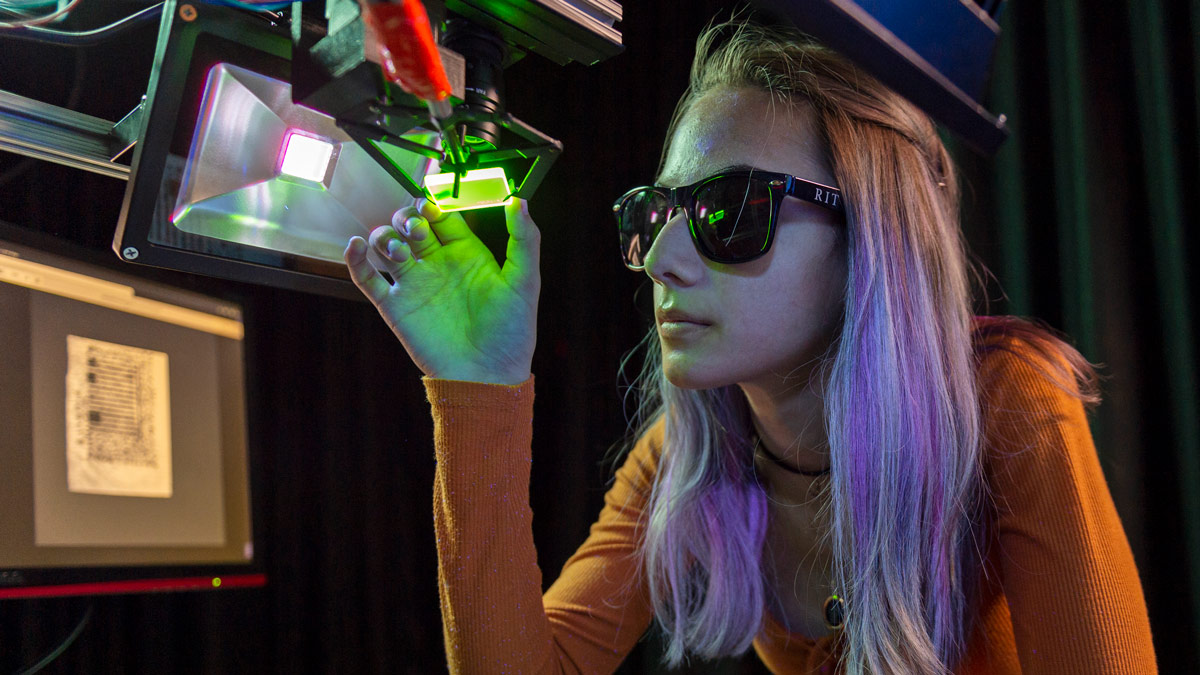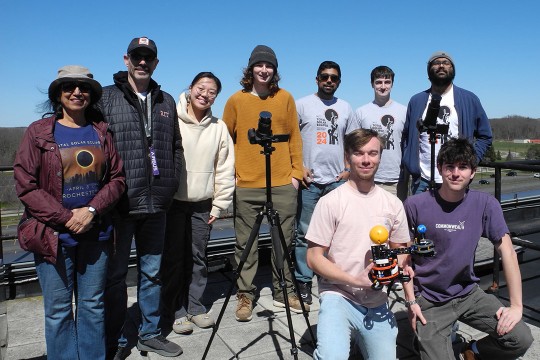Imaging Science Master of Science Degree

Imaging Science
Master of Science Degree
- RIT /
- Rochester Institute of Technology /
- Academics /
- Imaging Science MS
Advance your skills in imaging systems used in remote sensing, environmental science, and beyond with RIT’s imaging science MS.
Overview for Imaging Science MS
As digital image use continues to expand there is an increasing demand to fill dynamic imaging science careers. RIT’s imaging science MS provides the training and research opportunities needed to excel in industries like computer vision, astronomical imaging, satellite-based imaging systems and applications, virtual and augmented reality, and the use of UAVs (drones) in precision agriculture.
Master’s in Imaging Science at RIT: On-Campus or Online
Housed within the Chester F. Carlson Center for Imaging Science, RIT’s master's in imaging science is geared toward advancing and broadening the skills of professionals working and researching in the many industries where various imaging modalities are used to research and solve problems in engineering and science. This emerging field integrates engineering, math, physics, computer science, and psychology to understand and develop imaging systems and technology.
Students choose two courses from a variety of tracks such as: digital image processing, computer vision, electro-optical imaging systems, remote sensing, color imaging, optics, hard copy materials and processes, and nanoimaging. Tracks may be created for students interested in pursuing additional fields of study. The degree can be completed on-campus or online, and on a full or part-time basis.
An Imaging Science Curriculum Packed with High-Demand Skills
The imaging science curriculum emphasizes a systems approach to the study of imaging science. With a background in science or engineering, this degree will prepare you for positions in research, product development, and management in the imaging industry. The curriculum was developed in collaboration with industry partners to emphasize skills needed by their scientists, engineers, and managers. You may concentrate on one of several system tracks, or you may customize your own track. You may choose to complete either a research thesis or a project and a paper in the non-thesis option. You may also perform your thesis research at your place of employment.
- Research: Graduates apply their knowledge to research in areas of astronomy and space science, cultural artifact and document imaging, nanoimaging and materials, optics, remote sensing, and vision.
- Careers: Graduates work in various research and applied roles like imaging scientist, imaging systems scientist, imaging systems engineer, and systems engineer.
- Systems: Employers appreciate the ability of our graduates to apply the imaging chain towards a full systems perspective.
- Biomedical: Graduates are well prepared to contribute to both research and applied work in biomedical systems.
Research Thesis Option: The research thesis is based on experimental evidence obtained by the student in an appropriate field, as arranged between the student and their adviser. The minimum number of thesis credits required is four and may be fulfilled by experiments in the university’s laboratories. In some cases, the requirement may be fulfilled by work done in other laboratories or the student's place of employment, under the following conditions:
- The results must be fully publishable.
- The student’s advisor must be approved by the graduate program coordinator.
- The thesis must be based on independent, original work, as it would be if the work were done in the university’s laboratories.
Faculty within the Chester F. Carlson Center for Imaging Science supervise thesis research in areas of the physical properties of radiation-sensitive materials and processes, digital image processing, remote sensing, nanoimaging, electro-optical instrumentation, vision, computer vision, color imaging systems, and astronomical imaging. Interdisciplinary efforts are possible with the Kate Gleason College of Engineering and the College of Science.
Graduate Paper/Project Option: Students with demonstrated practical or research experience, approved by the graduate program coordinator, may choose the graduate project option. This option takes the form of a systems project course. The graduate paper is normally performed during the final semester of study. Both part- and full-time students may choose this option, with the approval of the graduate program coordinator.
Imaging Science Careers
Our imaging science graduates are in high demand across many government and industrial sectors including the mobile phone industry, consumer electronics, aerospace, precision agriculture and remote sensing, national defense, and a wide array of other application areas. Many of our students work in industry on internships during their graduate career at RIT, further expanding their education. Recent students have been hired as either interns or in permanent positions by companies such as Apple, Google, Motorola, Lockheed Martin, L3Harris, Corning, Los Alamos National Laboratory, MITRE Corporation, and many others.
-
Affordable Now. Valuable for Life.
Earn your master’s degree without the full price tag. With Master Up you can receive a 30% tuition scholarship for an RIT master’s degree.
-
Don't Delay Your Ambitions Until the Fall
This program offers a spring start, which means you can jumpstart your graduate journey and begin your studies this January.
-
Meet us on-campus on February 19
Learn about the programs that interest you. Hear from program faculty, speak with current graduate students, and ask the questions that will help you get one step closer to your career goals.
Careers and Cooperative Education
Typical Job Titles
| Satellite Applications and Research Scientist | Machine Learning/Deep Learning Engineer | Research Programmer |
| System Engineer | Image Scientist | Camera Component Engineer |
Cooperative Education
What makes an RIT science and math education exceptional? It’s the ability to complete science and math co-ops and gain real-world experience that sets you apart. Co-ops in the College of Science include cooperative education and internship experiences in industry and health care settings, as well as research in an academic, industry, or national lab. These are not only possible at RIT, but are passionately encouraged.
What makes an RIT education exceptional? It’s the ability to complete relevant, hands-on career experience. At the graduate level, and paired with an advanced degree, cooperative education and internships give you the unparalleled credentials that truly set you apart. Learn more about graduate co-op and how it provides you with the career experience employers look for in their next top hires.
Featured Work and Profiles
-
Exploring New Frontiers of Imaging Science
Anjali Jogeshwar '23 came to RIT for imaging science and found a world of opportunity, leading to a Ph.D. and a role as Senior Computer Vision Engineer at Circle Optics.
Read More about Exploring New Frontiers of Imaging Science -
RIT Imaging Science: The Perfect Major for Expanding Your Career
Ten years into his professional career, Gustavo Rahmer discovered the imaging science program at RIT and is now the Senior Instrumentation Engineer for the Giant Magellan Telescope.
Read More about RIT Imaging Science: The Perfect Major for Expanding Your Career -
Calibrating Apple Displays for Optimal Color Performance
While pursuing his MS in imaging science, Fu Jiang took a color science course which led to a Ph.D. in Color Science. Now he works at Apple ensuring displays have the best optical color performance.
Read More about Calibrating Apple Displays for Optimal Color Performance -
2018 Distinguished Alumni: Meet Steve Wear
Steve Wear was honored as Distinguished Alumnus during a ceremony within the College of Science. He is the co-founder and a member of the board of directors of Integrity Applications Inc.
Read More about 2018 Distinguished Alumni: Meet Steve Wear
Curriculum for 2025-2026 for Imaging Science MS
Current Students: See Curriculum Requirements
Note for online students
The frequency of required and elective course offerings in the online program will vary, semester by semester, and will not always match the information presented here. Online students are advised to seek guidance from the listed program contact when developing their individual program course schedule.
Students are also interested in
Admissions and Financial Aid
This program is available on-campus or online.
On Campus
| Offered | Admit Term(s) | Application Deadline | STEM Designated |
|---|---|---|---|
| Full-time | Fall or Spring | Fall - January 15 priority deadline, rolling thereafter; Spring - rolling | Yes |
| Part-time | Fall or Spring | Rolling | No |
Online
| Offered | Admit Term(s) | Application Deadline | STEM Designated |
|---|---|---|---|
| Part-time | Fall or Spring | Rolling | No |
Full-time study is 9+ semester credit hours. Part-time study is 1‑8 semester credit hours. International students requiring a visa to study at the RIT Rochester campus must study full‑time.
Application Details
To be considered for admission to the Imaging Science MS program, candidates must fulfill the following requirements:
- Complete an online graduate application.
- Submit copies of official transcript(s) (in English) of all previously completed undergraduate and graduate course work, including any transfer credit earned.
- Hold a baccalaureate degree (or US equivalent) from an accredited university or college. A minimum cumulative GPA of 3.0 (or equivalent) is recommended.
- Satisfy prerequisite requirements and/or complete bridge courses prior to starting program coursework.
- Submit a current resume or curriculum vitae.
- Submit a personal statement of educational objectives.
- Submit two letters of recommendation.
- Entrance exam requirements: GRE optional but recommended. No minimum score requirement.
- Submit English language test scores (TOEFL, IELTS, PTE Academic, etc.), if required. Details are below.
English Language Test Scores
International applicants whose native language is not English must submit one of the following official English language test scores. Some international applicants may be considered for an English test requirement waiver.
Duolingo (DET): 140
IELTS: 7.5
LanguageCert Academic: 84
PTE Academic: 76
TOEFL: 100
International students below the minimum requirement may be considered for conditional admission. Deaf and hard-of-hearing test takers with significant hearing loss do not need to take the listening and speaking sections for the TOEFL and IELTS. Each program requires balanced sub-scores when determining an applicant’s need for additional English language courses.
How to Apply Start or Manage Your Application
Cost and Financial Aid
An RIT graduate degree is an investment with lifelong returns. Graduate tuition varies by degree, the number of credits taken per semester, and delivery method. View the general cost of attendance or estimate the cost of your graduate degree.
A combination of sources can help fund your graduate degree. Learn how to fund your degree
Additional Information
Prerequisites
Applicants must have completed courses in mathematics (through calculus and including differential equations), and a full year of calculus-based physics (including modern physics). It is assumed that students can write a common computer program.
Online Degree Information
The online Imaging Science MS program is designed for part-time study and can be completed fully online. It is flexible for working professionals. Students typically say they spend between 10-12 hours per week on their classes and take one class per term. Most students finish in about 2.5 years but can be expedited if you study year-round and take more than one class each semester. For specific details about the delivery format and learning experience, contact the Program Contact listed on this page. RIT does not offer student visas for online study.
Online Tuition Eligibility
The online Imaging Science MS is a designated online degree program that is billed at a 43% discount from our on-campus rate. View the current online tuition rate.
Online Study Restrictions for Some International Students
Certain countries are subject to comprehensive embargoes under US Export Controls, which prohibit virtually ALL exports, imports, and other transactions without a license or other US Government authorization. Learners from the Crimea region of the Ukraine, Cuba, Iran, North Korea, and Syria may not register for RIT online courses. Nor may individuals on the United States Treasury Department’s list of Specially Designated Nationals or the United States Commerce Department’s table of Deny Orders. By registering for RIT online courses, you represent and warrant that you are not located in, under the control of, or a national or resident of any such country or on any such list.
Accreditation
Research
The College of Science consistently receives research grant awards from organizations that include the National Science Foundation, National Institutes of Health, and NASA, which provide you with unique opportunities to conduct cutting-edge research with faculty. The Chester F. Carlson Center for Imaging Science is a unique, interdisciplinary academic unit bringing together the fields of physics, mathematics, engineering, and computer science in the development of new imaging systems and their applications across a wide range of disciplines.
The Imaging Science graduate program has over 100 students doing research on topics such as:
- computer vision
- astronomical imaging
- satellite-based imaging systems and applications
- virtual and augmented reality
- the use of UAVs in precision agriculture
Students are supported by 18 core program faculty in the Center and another 15+ affiliated faculty members across RIT.
Faculty from the Center conduct research on a broad variety of topics including:
- astronomy
- cultural heritage imaging
- detectors and imaging systems
- human and computer vision
- remote sensing
- nanoimaging
- magnetic resonance
- optical imaging
Learn more by exploring the Carlson Center’s imaging science research areas.
Related News
-
November 19, 2025

RIT innovation helps illuminate lost history
The goal of libraries, museums, and archives around the world is to safeguard historical documents, but some objects can deteriorate with time. RIT’s Cultural Heritage Imaging (CHI) lab is using funding from the National Endowment for the Humanities to develop a relatively low-cost system that makes cultural heritage imaging methods more accessible.
-
April 22, 2025

Virtually endless possibilities: RIT researchers push boundaries with immersive technologies
RIT researchers are pushing the boundaries with immersive technologies, including augmented reality (AR), virtual reality (VR), extended reality (XR), and mixed reality (MR).
-
April 10, 2024

University researchers measure the sun during the eclipse to assess impact on solar arrays
The recent total solar eclipse over Rochester provided a once-in-a-lifetime opportunity on Earth for two faculty-researchers and their students to capture data about the effects of the sun’s energy during a total eclipse.
Contact
- Lindsay Lewis
- Senior Assistant Director
- Office of Graduate Admissions
- Enrollment Management
- 585‑475‑5532
- lslges@rit.edu
- Anthony Vodacek
- Professor
- Chester F. Carlson Center for Imaging Science
- College of Science
- 585‑475‑7816
- axvpci@rit.edu
Chester F. Carlson Center for Imaging Science





















